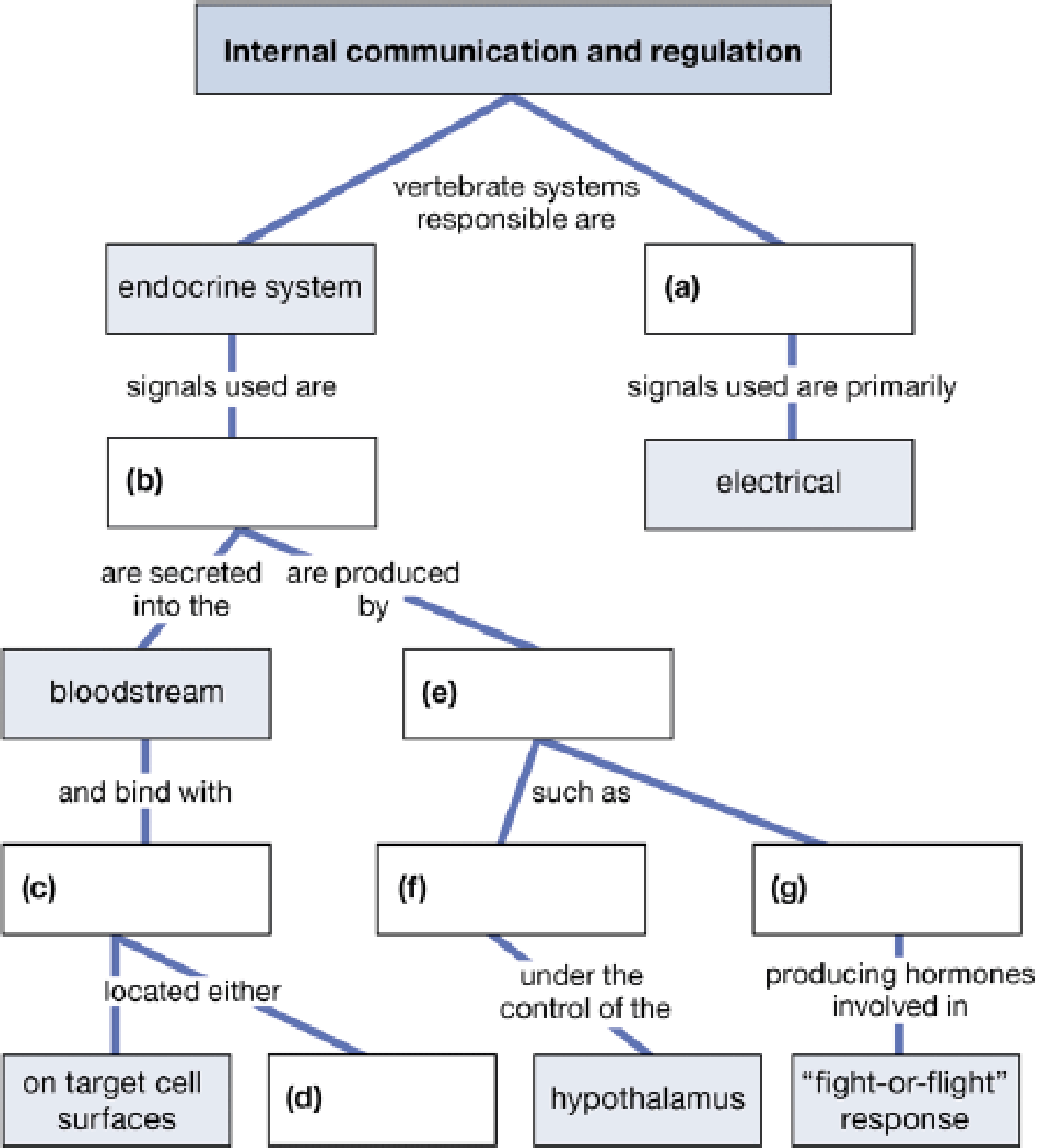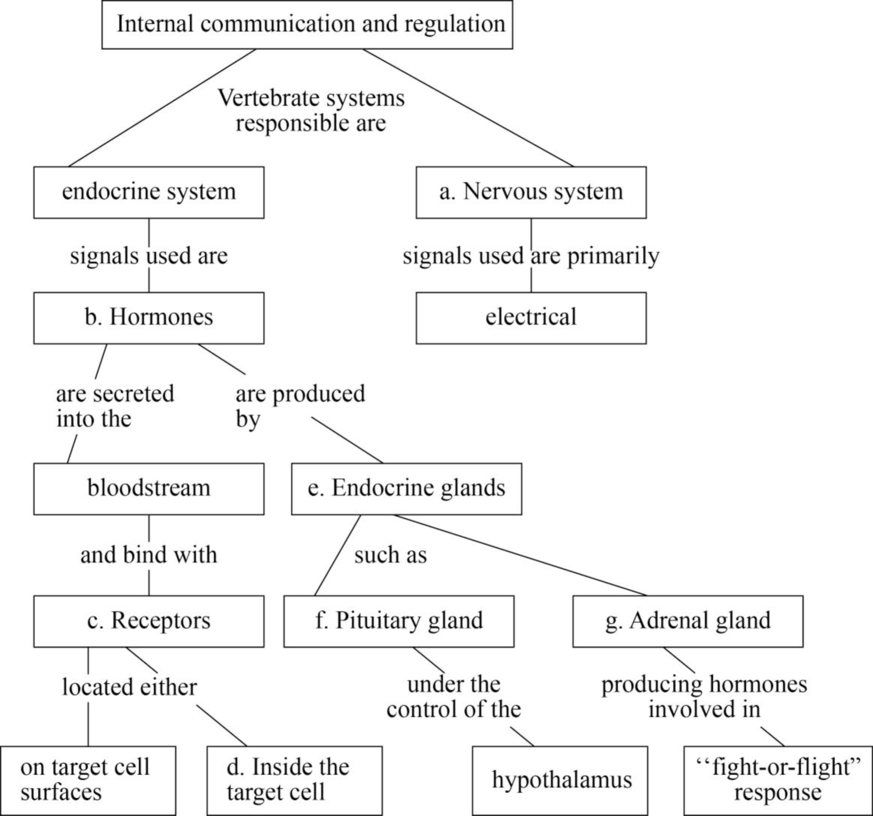
Concept explainers
Complete this map, which presents some major concepts from this chapter.

To complete: The given map that shows the internal communication and regulation.
Introduction: There are two major ways of internal regulation and communication. These are regulated by hormones (chemical substances) and neuronal communication (electrical signals). Neuronal regulation is carried out by neurons either electrically or by the help of neurotransmitters. Hormonal regulation is carried out by hormones that are usually peptides or steroid molecules.
Answer to Problem 1CC
Pictorial representation: Fig. 1 represents the chart of the internal communication and regulation by hormones in vertebrates.

Fig. 1: Internal communication and regulation.
Explanation of Solution
(a)
Correct answer: Nervous system
The nervous system is the organ system of the body, which conducts nerve impulses in the form of electrical signals that pass along the dendrites to generate an action potential. Hence, the correct answer is nervous system.
(b)
Correct answer: Hormones
Hormones are the chemical substances that are secreted by a special group of cells or tissues called the endocrine glands. They pour their secretions into the bloodstream. The exocrine glands are also found in our bodies, which pour their secretions in a tube or a duct. Hence, the correct answer is hormones.
(c)
Correct answer: Receptors
Receptors are the structures that are mostly made up of proteins whose function, as the name suggests, is that they receive the signals or the chemicals or hormones and thereby transmit or elicit a response in the cell on which they are present. Hence, the correct answer is receptors.
(d)
Correct answer: Inside the target cell
Receptors are present inside or outside the cell. They receive the hormones that are secreted by the endocrine glands. Their functioning is regulated either by the hormone itself or by some other biomolecules. Hence, the correct answer is inside the target cell.
(e)
Correct answer: Endocrine glands
Hormones are the chemical substances or biomolecules that are secreted or formed by the endocrine cells. The chemical substances that are formed by the exocrine glands are called secretions. Secretions are poured into a tube or a duct, whereas the hormones are secreted directly into the bloodstream. Hence, the correct answer is endocrine glands.
(f)
Correct answer: Pituitary gland
The pituitary gland is also called the master gland as it controls the functioning of all the other endocrine glands. However, this gland is also regulated by the hypothalamus, which is a part of the brain. Hence, the correct answer is pituitary gland.
(g)
Correct answer: Adrenal gland
The adrenal gland is also called the suprarenal gland as it is located above the kidneys. It secretes a hormone called adrenaline, which is also called the 3F hormone or the emergency hormone as this provides the support for the response that is needed in emergency conditions like fighting or in fearful conditions. Hence, the correct answer is adrenal gland.
Want to see more full solutions like this?
Chapter 26 Solutions
Campbell Biology: Concepts & Connections (9th Edition)
- Describe the principle of homeostasis.arrow_forwardExplain how the hormones of the glands listed below travel around the body to target organs and tissues : Pituitary gland Hypothalamus Thyroid Parathyroid Adrenal Pineal Pancreas(islets of langerhans) Gonads (testes and ovaries) Placentaarrow_forwardWhat are the functions of the hormones produced in the glands listed below: Pituitary gland Hypothalamus Thyroid Parathyroid Adrenal Pineal Pancreas(islets of langerhans) Gonads (testes and ovaries) Placentaarrow_forward
- Describe the hormones produced in the glands listed below: Pituitary gland Hypothalamus Thyroid Parathyroid Adrenal Pineal Pancreas(islets of langerhans) Gonads (testes and ovaries) Placentaarrow_forwardPlease help me calculate drug dosage from the following information: Patient weight: 35 pounds, so 15.9 kilograms (got this by dividing 35 pounds by 2.2 kilograms) Drug dose: 0.05mg/kg Drug concentration: 2mg/mLarrow_forwardA 25-year-old woman presents to the emergency department with a 2-day history of fever, chills, severe headache, and confusion. She recently returned from a trip to sub-Saharan Africa, where she did not take malaria prophylaxis. On examination, she is febrile (39.8°C/103.6°F) and hypotensive. Laboratory studies reveal hemoglobin of 8.0 g/dL, platelet count of 50,000/μL, and evidence of hemoglobinuria. A peripheral blood smear shows ring forms and banana-shaped gametocytes. Which of the following Plasmodium species is most likely responsible for her severe symptoms? A. Plasmodium vivax B. Plasmodium ovale C. Plasmodium malariae D. Plasmodium falciparumarrow_forward
- please fill in missing parts , thank youarrow_forwardplease draw in the answers, thank youarrow_forwarda. On this first grid, assume that the DNA and RNA templates are read left to right. DNA DNA mRNA codon tRNA anticodon polypeptide _strand strand C с A T G A U G C A TRP b. Now do this AGAIN assuming that the DNA and RNA templates are read right to left. DNA DNA strand strand C mRNA codon tRNA anticodon polypeptide 0 A T G A U G с A TRParrow_forward
- Health Safety And Nutrition F/Young ChildHealth & NutritionISBN:9781305144767Author:MAROTZPublisher:Cengage
 Biology Today and Tomorrow without Physiology (Mi...BiologyISBN:9781305117396Author:Cecie Starr, Christine Evers, Lisa StarrPublisher:Cengage LearningCase Studies In Health Information ManagementBiologyISBN:9781337676908Author:SCHNERINGPublisher:Cengage
Biology Today and Tomorrow without Physiology (Mi...BiologyISBN:9781305117396Author:Cecie Starr, Christine Evers, Lisa StarrPublisher:Cengage LearningCase Studies In Health Information ManagementBiologyISBN:9781337676908Author:SCHNERINGPublisher:Cengage  Biology (MindTap Course List)BiologyISBN:9781337392938Author:Eldra Solomon, Charles Martin, Diana W. Martin, Linda R. BergPublisher:Cengage Learning
Biology (MindTap Course List)BiologyISBN:9781337392938Author:Eldra Solomon, Charles Martin, Diana W. Martin, Linda R. BergPublisher:Cengage Learning





